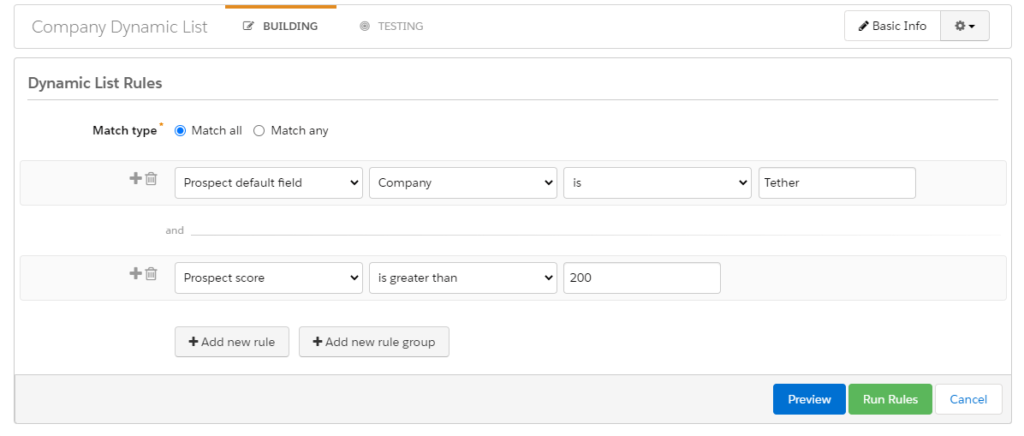
Pardot is the Marketing Automation side of Salesforce, and it has some high performance tools straight out of the box.
Part of what I do for Tether is demonstrating Pardot features and functionality to prospective clients, and it takes me back to the beginning of my journey with Pardot.
One question I regularly get asked is “what exactly does it do?”
The list is long and distinguished, but one thing I always stress to clients is it makes your life an awful lot easier as a marketer, while giving you insight into what assets work well, campaign success, first touch attribution and ultimately ROI. We can score and Grade our prospects to see what their interest is in us, and what our interest should be in them, building an ideal buyer persona. We can tie in our Social Media, and even get data on any Advertisements that we put on 3rd Party websites etc. Pardot is your marketing hub.
Lets take a look at some of my favourite features:
Automation, Communication and Segmentation:
Tasks that historically would be arduous and time consuming are taken out of your hands by Pardot, it handles scheduling for your marketing efforts, it utilises templates for easy building of emails and landing pages, and it also brings automation to your lists, if you want it to, for example:
1. Dynamic Lists
One of my favourite tools within Pardot is the Dynamic List, a simple yet incredibly effective and hard working tool, a list that constantly refreshes and stays fresh and up to date. As opposed to a static list, that you manually add and delete prospects from, I refer to the Dynamic list as the static lists smarter brother. Dynamic lists are rule based, and constantly running, so prospects match on and unmatch off your lists, depending on the criteria you set. For example:
Here I have built a dynamic list that segments prospects by company;

The criteria that I have set for this list is that the prospects company must be Tether, we could use this list if we regularly sent out emails to staff at a particular company, or if we wanted to target these employees using an engagement program, (we will look at those later). The beauty of Dynamic lists is that prospects match on and unmatch off this list, so what happens if we change a prospects company name to something else? Well we wait for the list to refresh, and when it does, we get an email from Pardot telling us that the contents of this list have changed, and the prospect drops off the list, meaning we have a consistent and up to date list of people who work at Tether! Dynamic lists tie in automation and segmentation, meaning they are constantly monitoring your prospects. See our previous blog on Dynamic lists below:
Some other great uses for Dynamic lists are:
- List of prospects with a score above x.
- List of prospects with Industry x.
- List of prospects with job title x.
We can even set a dynamic list for unengaged prospects, with criteria such as:
- Have neither clicked on a tracked link nor filled out a form for 6 months
- Have not opened an email for 6 months
- Have been emailed at least 6 times in 6 months

2.Engagement Studio:
Another incredible feature of Pardot is the ability to plan out campaigns of engagement and nurture. We’ve seen above how we can create a fresh and up to date list of particular prospects, so we can use these lists and send the people on them a series of targeted and relevant emails, through engagement studio.
We can create an engagement campaign, and can set out a series of scheduled emails, that are set to fire on particular dates, and the program will monitor and react to email opens, link clicks, and landing page completions, we can add a score to prospects that react to the mails, and we can even further segment the prospects on this journey to dictate which are hot and cold leads! An amazing way to set out a customer journey and have actions taken at each step.
Depending on the duration of these programs, you can set wait times between emails, ie the first one goes out, and we can set a week wait time until the next one, as to not bombard people with consecutive emails, and we can dictate that if someone clicks a link on the first mail, they get added to a list or have a follow up from sales, and they recieve no more emails from that campaign. A really smart tool, and you set it in motion and watch it go. Again saving a massive amount of time.

Here is a link to Pardots examples of Engagement Studio:
https://www.pardot.com/training/engagement-studio-commonly-used-templates/
3. Email Templates
Spend time now, save time later:
Templates save time, simple as that, so with Pardot we can invest in building great templates and reusing them in our communications. We can keep them as simple as we like or make them complex, but to me they must be clear, branded and open. You can build an email template in 10 mins, and reuse it every week depending on your use case. I love templates, they save so much time and really keep things consistent.

As I said in a previous blog, Pardot and Salesforce are the dream team, so any templates that you build for emails in Pardot, can be made available for Salesforce users, again spreading consistency and branding across your entire business. Sales users can access the amazing templates that you build in Pardot, and you can set that only certain areas of the mail are editable, so your masterpiece stays as you intend it.
These are just three of the features that I use week in week out in Pardot, and three that I always get excited about in training and demo, for numerous reasons, but who doesn’t want to save time and effort every week. Pardot is the best Marketing tool ive used, and what’s most impressive, it keeps getting better!
Hope you are all staying safe and well,
The Tether Team.
#marketingautomation #pardot #salesforcepardot #tethertips




